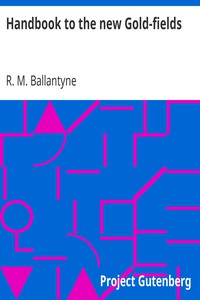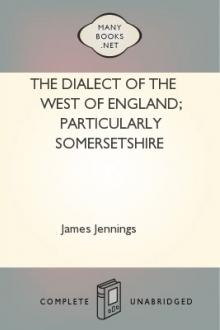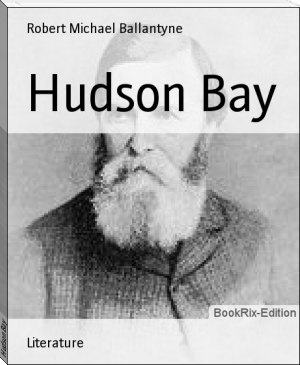Handbook to the new Gold-fields, R. M. Ballantyne [mobi reader android .TXT] 📗

- Author: R. M. Ballantyne
Book online «Handbook to the new Gold-fields, R. M. Ballantyne [mobi reader android .TXT] 📗». Author R. M. Ballantyne
“While such and so great is the power of circumstances to vary the impressions made upon the senses, some hesitation must be used in their reception until fully confirmed, or they must be limited by other accounts, as unbiassed judgment may direct, especially as the temperament of individuals may serve to heighten the colouring, whether sombre or sunny, in which circumstances may have depicted the landscape. It is not every traveller who can, with Mackenzie, expatiate on the beauty of scenery while in fear of treachery from fickle and bloody savages; or like Fremont, though dripping from the recent flood, and uncertain of the means of existence even for the day, his arms, clothes, provisions, instruments, deep in the whirlpools of the foaming Platte, stop to gaze with admiration on the ‘fantastic ruins’ Nature has ‘piled’ among her mountain fastnesses, while from his bare and bleeding feet he draws the sharp spines of the hostile cacti. Truth from travellers is consequently for the most part relative. Abstractedly, with reference to any country, it must be derived from the combined accounts and different phases of truth afforded by many.”
“Destiny, which has lately riveted our attention on the burning plains of the extreme East,” says the Times of 9th July, “now claims our solicitude for the auriferous mountains and rushing rivers of the Far West and the shores of the remote Pacific. What most of us know of these ultra-occidental regions may be summed up in a very few words. We have most of us read Washington Irving’s charming narrative of ‘Astoria,’ sympathised with the untimely fate of Captain Thorn and his crew, and read with breathless interest the wanderings of the pilgrims to the head waters of the Columbia. After thirty years, the curtain rises again on the stormy period of the Ashburton Treaty, when the ‘patriots’ were bent upon ‘whipping the Britishers’ out of every acre of land on the western side of the Rocky Mountains. And now, for the third time, we are recalled to the same territory, no longer as the goal of the adventurous trader or the battle ground of the political agitator, but as a land of promise—a new El Dorado, to which men are rushing with all the avidity that the presence of the one, thing which all men, in all times and in all places, insatiably desire is sure to create.”
This El Dorado lies between the Rocky Mountains and the Pacific; it is bounded on the south by the American frontier line, 49 degrees of latitude, and may be considered to extend to the sources of Fraser River, in latitude 55 degrees. It is, therefore, about 420 miles long in a straight line, its average breadth from 250 to 300 miles. Taken from corner to corner, its greatest length would be, however, 805 miles,—and its greatest breadth 400 miles, Mr Arrowsmith computes its area of square miles, including Queen Charlotte’s Island, at somewhat more than 200,000 miles. Of its two gold-bearing rivers, one, the Fraser, rises in the northern boundary, and flowing south, falls into the sea at the south-western extremity of the territory, opposite the southern end of Vancouver’s Island, and within a few miles of the American boundary; the other, the Thompson River, which rises in the Rocky Mountains, and flowing westward, joins the Fraser about 150 miles from the coast. It is on these two rivers, and chiefly at their confluence, that the gold discoveries have been made.
Fraser River is about as famous a point as there is today on the earth’s surface—as famous as were the Californian diggings in 1848, or the Australian gold mines in 1853. It is now the centre of attraction for the adventurous of all countries. The excitement throughout the Canadas and Northern States of America is universal. In fact, the whole interior of North America is quite in a ferment—the entire floating population being either “on the move,” or preparing to start; while traders, cattle-dealers, contractors, and all the enterprising persons in business who can manage to leave, are maturing arrangements to join the general exodus. Persons travelling in the mining regions reckon that, in three months, 50,000 souls will have left the State of California alone. The rapidity and extent of this emigration has never been paralleled.
It is now established that the district of British Columbia, holding a relation to Puget’s Sound similar to that of Sacramento Valley to the Bay of San Francisco, contains rich and extensive gold beds. The Fraser River mines have already been mentioned in the British Parliament as not less valuable and important than the gold fields in Australia, Geologists have anticipated such a discovery; and Governor Stevens, in his last message to the Legislative Assembly of Washington Territory, claims that the district south of the international boundary is equally auriferous.
The special correspondent of the San Francisco Bulletin, a reliable authority, writes from Fort Langley, twenty-five miles up the Fraser, under date the 25th May, that he had just come down from Fort Yale, where he found sixty men and two hundred Indians, with their squaws, at work on a “bar” of about five hundred yards in length—called “Hills Bar,” one mile below Fort Yale, and fifteen miles from Fort Hope, all trading posts of the Hudson’s Bay Company. “The morning I arrived, two men (Kerrison and Company) cleaned up five and a-half ounces from the rocker, the product of half a day’s work. Kerrison and Company the next day cleaned up ten and a-half ounces from two rockers, which I saw myself weighed. This bar is acknowledged to be one of the richest ever seen, and well it may be, for here is a product of fifteen and a-half ounces of gold, worth 247 and a half dollars, or 50 pounds sterling, from it in a day and a-half to the labour of two rockers. Old Californian miners say they never saw such rich diggings. The average result per day to the man was fully 20 dollars, some much more. The gold is very fine; so much so, that it was impossible to save more than two-thirds of what went through the rockers. This defect in the rocker must be remedied by the use of quicksilver to ‘amalgamate’ the finer particles of gold. This remedy is at hand, for California produces quicksilver sufficient for the consumption of the ‘whole’ world in her mountains of Cinnabar. Supplies are going on by every vessel. At Sailor Diggings, above Fort Yale, they are doing very well, averaging from 8 to 25 dollars per day to the man. I am told that the gold is much coarser on Thompson River than it is in Fraser River. I saw yesterday about 250 dollars of coarse gold from Thompson River, in pieces averaging 5 dollars each. Some of the pieces had quartz among them. Hill, who was the first miner on the bar bearing his name, just above spoken of, with his partner, has made some 600 dollars on it in almost sixteen days’ work. Three men just arrived from Sailor Diggings have brought down 670 dollars in dust, the result of twelve days’ work. Gold very fine. Rising of the river driving the miners off for a time.”
Correspondents from several places on the Sound, both on the British and American territories, men of various nationalities, have since written that the country on the Fraser River is rich in gold, and “equal to any discoveries ever made in California.” The Times’ correspondent, writing from Vancouver’s Island on 10th June, says, “The gold exists from the mouth of Fraser River for at least 200 miles up, and most likely much further, but it has not been explored; hitherto any one working on its banks has been able to obtain gold in abundance and without extraordinary labour; the gold at present obtained has been within a foot of the surface, and is supposed to have averaged about ten dollars per diem to each man engaged in mining. Of course, some obtain more, some less, but all get gold. Thompson River is quite as rich in gold as Fraser River. The land about Thompson River consists of extensive sandy prairies, which are loaded with gold also; in fact, the whole country about Fraser and Thompson Rivers are mere beds of gold, so abundant as to make it quite disgusting. I have already seen pounds and pounds of it, and hope before long to feast my eyes upon tons of the precious metal.” And the same high authority writes on 17th June,—“There is no longer room to doubt that all the country bordering on Fraser River is one continuous gold bed. Miners abandoning the partially exhausted placers of California, are thronging to this new Dorado, and the heretofore tranquil precincts of Victoria are now the scene of an excitement such as was witnessed at San Francisco in 1849, or since in Melbourne. Land has run up to prices fabulously high; and patches that six months ago were, perhaps, grudgingly purchased at the colonial price of 20 shillings the acre, are re-selling daily at a hundred times that amount. The small number of steam ships hitherto found sufficient for the commerce between San Francisco and these vicinities no longer suffices to convey a tithe of the eager applicants for passage. An opening for the enterprise of British capitalists such as was not anticipated has thus suddenly arisen, and the opportunity will, of course, be seized with alacrity.
“Lest I should appear too sanguine in my representations, I will cite one instance to illustrate the richness of these newly discovered diggings. Three men returned for provisions lately, after an absence of seven days; they had during this interval extracted 179 ounces of gold. I state this fact on the authority of Governor Douglas, who has just returned from the mining regions, whither he went with the view of establishing certain regulations for the maintenance of order. In short, all who have visited the mines are impressed with the conviction that their richness far excels that of California in its palmiest days.”
And, again, the correspondent of the New York Times, in a letter dated 21st June, gives the following corroborative testimony:—“The gold is found everywhere, and even during the extreme height of the river, parties are averaging from ten to twenty dollars per day, digging in the banks or on the upper edge of the bars, nearly all of which are overflowed. Big strikes of from fifty to two hundred and fifty dollars are frequently reported. Nearly all the work at present is carried on between Forts Langley and Yale, and for some twenty or thirty miles above the latter an entire distance along the river of about a hundred miles. Some few are digging on Harrison River, and other tributaries, where the gold is found in larger particles. Those who





Comments (0)